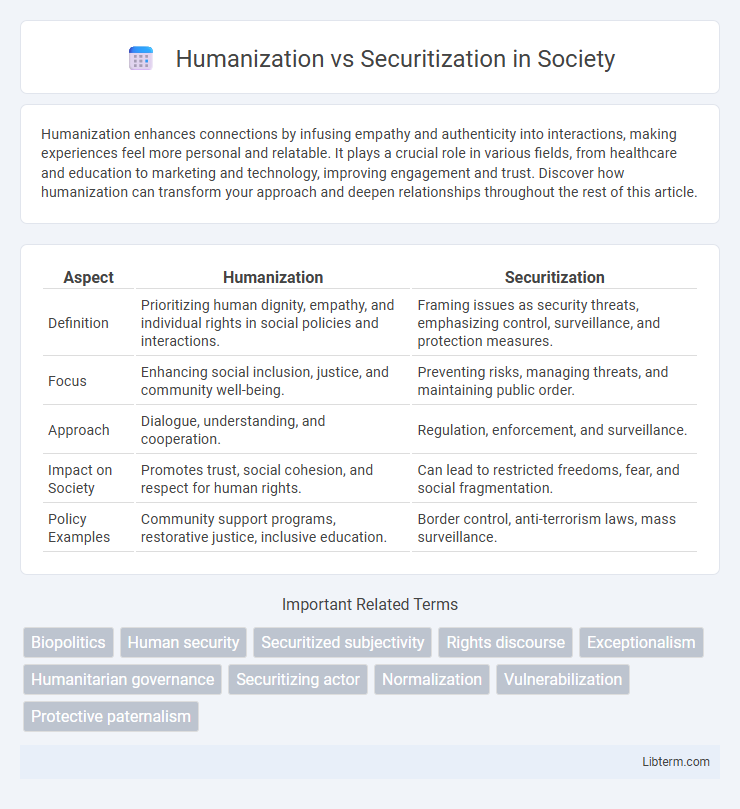Humanization enhances connections by infusing empathy and authenticity into interactions, making experiences feel more personal and relatable. It plays a crucial role in various fields, from healthcare and education to marketing and technology, improving engagement and trust. Discover how humanization can transform your approach and deepen relationships throughout the rest of this article.
Table of Comparison
| Aspect | Humanization | Securitization |
|---|---|---|
| Definition | Prioritizing human dignity, empathy, and individual rights in social policies and interactions. | Framing issues as security threats, emphasizing control, surveillance, and protection measures. |
| Focus | Enhancing social inclusion, justice, and community well-being. | Preventing risks, managing threats, and maintaining public order. |
| Approach | Dialogue, understanding, and cooperation. | Regulation, enforcement, and surveillance. |
| Impact on Society | Promotes trust, social cohesion, and respect for human rights. | Can lead to restricted freedoms, fear, and social fragmentation. |
| Policy Examples | Community support programs, restorative justice, inclusive education. | Border control, anti-terrorism laws, mass surveillance. |
Understanding Humanization in Modern Societies
Humanization in modern societies emphasizes recognizing individual dignity, empathy, and social inclusion to foster community well-being and reduce marginalization. This approach promotes policies centered on human rights, social justice, and equitable access to resources, contrasting with securitization's emphasis on control, surveillance, and threat management. Understanding humanization requires analyzing its impact on social cohesion, mental health, and conflict resolution within diverse cultural and political frameworks.
Defining Securitization and Its Implications
Securitization involves framing issues as existential threats that require extraordinary measures beyond regular political procedures, often leading to the suspension of normal rights and democratic processes. This process transforms political challenges into security problems, justifying urgent and exceptional responses from state actors. The implications include potential erosion of civil liberties, increased state surveillance, and the normalization of emergency powers, which can alter the balance between security and human rights.
Historical Evolution: From Securitization to Humanization
The historical evolution from securitization to humanization reflects a shift in policy and societal priorities, emphasizing individual rights and social welfare over purely security-driven measures. Early securitization focused on managing risks through stringent controls and surveillance, often at the expense of personal freedoms and social inclusion. Over time, humanization gained prominence by promoting restorative justice, community engagement, and the recognition of humanity within security frameworks.
Human Rights Perspectives: Humanization vs Securitization
Humanization emphasizes protecting individual dignity and upholding human rights by prioritizing humanitarian approaches and inclusive policies. Securitization frames issues as existential threats, often leading to restrictive measures that can undermine civil liberties and human rights protections. Balancing human rights perspectives requires ensuring security measures do not compromise fundamental freedoms or perpetuate discrimination.
Policy Frameworks and Approaches
Policy frameworks for humanization prioritize inclusive, rights-based approaches that emphasize dignity, accessibility, and social equity in public services. In contrast, securitization frameworks focus on risk mitigation, regulatory control, and the enforcement of protective measures, often prioritizing safety over individual freedoms. These differing approaches shape the development and implementation of policies by balancing humanitarian values against security imperatives within governance systems.
Security-Driven Narratives in Media and Politics
Security-driven narratives in media and politics intensify public fear by emphasizing threats such as terrorism, immigration, and cybersecurity breaches, thereby justifying increased surveillance and restrictive policies. These narratives often dehumanize targeted groups, reducing complex social issues to binary conflicts between "us" and "them," which undermines empathy and fuels social polarization. The securitization process leverages sensationalism and framing to prioritize state security over human rights, influencing public opinion and legislative agendas toward exclusionary and punitive measures.
Social Impact: Empathy Versus Fear
Humanization in social contexts fosters empathy by highlighting shared experiences and encouraging understanding across diverse groups, leading to stronger community bonds and cooperative behaviors. Securitization, however, often exploits fear by framing issues as existential threats, which can increase social division, discrimination, and exclusion. Emphasizing empathy instead of fear promotes social inclusion and resilient societies better equipped to address collective challenges.
Humanization in Healthcare and Public Services
Humanization in healthcare and public services emphasizes personalized care that respects patients' dignity, empathy, and active participation, improving patient outcomes and satisfaction. It integrates patient-centered communication, emotional support, and cultural competence to foster trust and collaboration between providers and patients. Prioritizing humanization reduces medical errors and enhances the overall effectiveness of healthcare systems by addressing holistic needs beyond clinical treatments.
Case Studies: Real-World Consequences
Case studies on Humanization vs Securitization reveal stark contrasts in policy outcomes, with humanization approaches improving refugee integration and mental health, while securitization often leads to heightened border controls and increased human rights violations. In the European migrant crisis, countries adopting humanization strategies saw lower rates of asylum seeker detention and better social cohesion compared to those emphasizing securitization. Data from the U.S.-Mexico border highlights how securitization policies correlate with increased migrant deaths and prolonged family separations, underscoring real-world humanitarian costs.
Balancing Security and Humanity: Toward Inclusive Solutions
Balancing security and humanity requires integrating human rights principles into securitization policies to ensure protection without marginalization. Inclusive solutions promote community engagement, addressing root causes of insecurity while safeguarding vulnerable populations. Emphasizing empathy and accountability fosters trust, enabling effective security measures that respect human dignity.
Humanization Infographic

 libterm.com
libterm.com